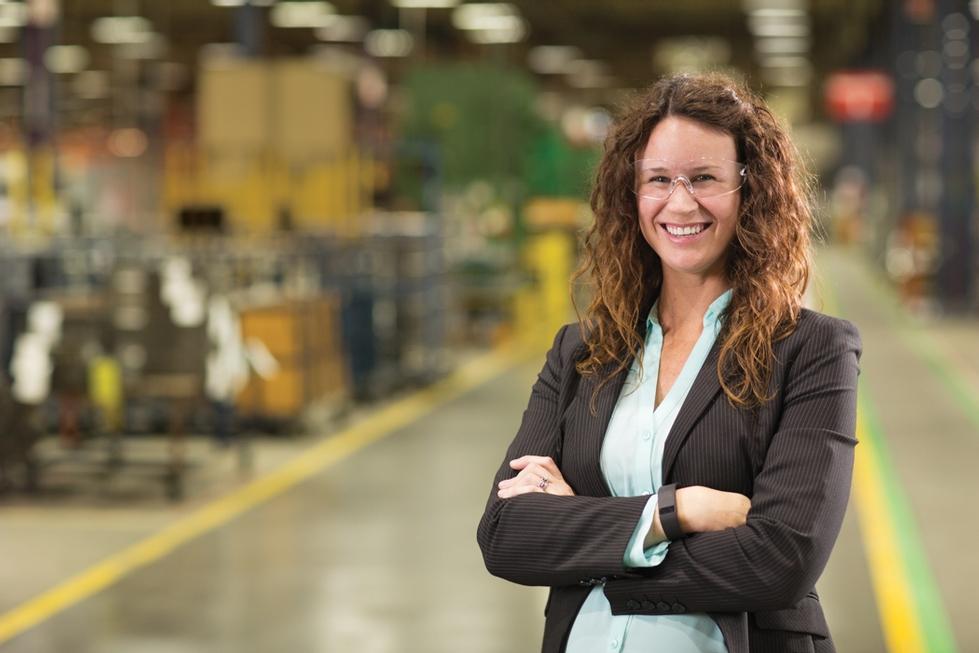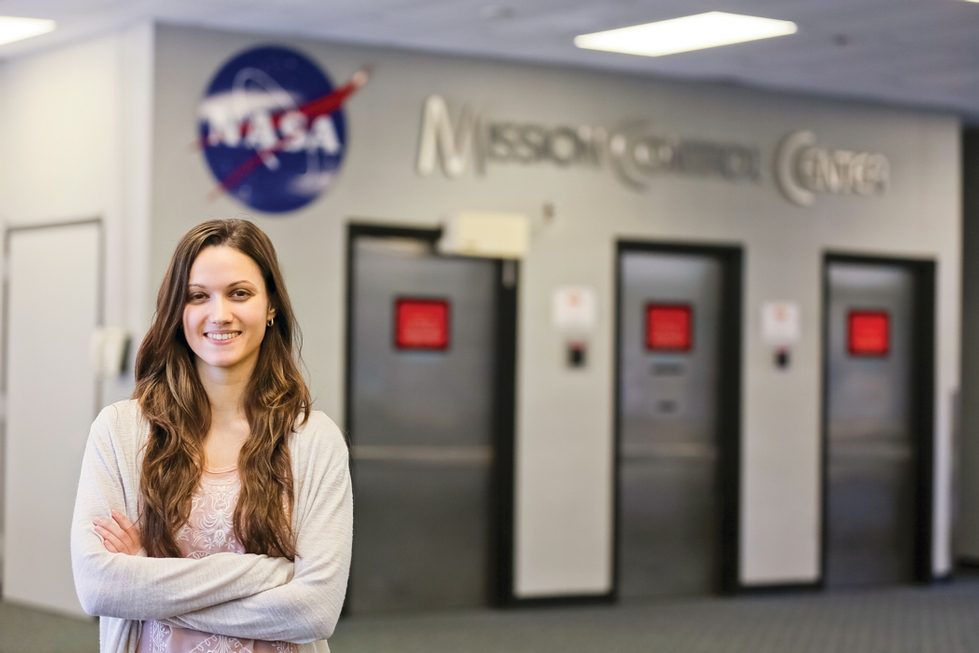Empowered. Educated. Engineers.
Women narrow gender gap
by Leah Twilley
Sofia Fanourakis broke a lot of things as a child, but for a good reason.
She broke them so she could put them back together, to see how the pieces fit and worked with each other. Perhaps that was the first sign she would become an engineer and go on to work at NASA while attending Grand Valley. Or maybe it is because she grew up with like-minded thinkers, as many of her family members are engineers or computer scientists.
Fanourakis, an electrical engineering major and native of Crete, Greece, is part of a population that is succeeding in a field often populated by men. Women who are Grand Valley alumnae, faculty members and students are breaking traditional barriers and closing the gender gap in STEM (science, technology, engineering, mathematics) fields.

Leah Olsen has worked at Steelcase for eight years.
photo by Amanda Pitts
Standouts at Steelcase, NASA
Leah Olsen, ’07, is going on eight years as a product design engineer for Steelcase, working in the seating and product development department.
From an early age, she thought engineering was about working on cars and getting dirty. “So I thought maybe I’ll become an architect because I enjoy drawing and art,” said Olsen, a native of Ohio. Tag-alongs with her dad, who is an electrical engineer, to wire houses showed her a different side of engineering.
“I was really drawn to a mix of art and math,” she said.
“As a student, I remember thinking about the idea of designing and building consumer products. When a piece of a pen doesn’t work, I wondered, ‘Who made that design decision and why?’ A lot of it is the design, but it’s the engineering that goes into it and the tests and trials that make a product perfect.”
Today, Olsen develops chairs for educational and office settings. She makes test specifications and works with a lab and model shop to create prototypes for testing. She has engineered chairs that are now used at Grand Valley and has conducted site testing on the Allendale Campus. At any given time, she could be working on three or four projects. And sometimes she does get her hands dirty.
“After a product is launched, we’ll need to make small changes here and there, so I visit the plant and factory to figure out what the problem is,” she said.
Olsen said Grand Valley prepared her for the workforce.
“You can memorize formulas or Google answers easily, but you have to learn how to apply knowledge, manage time, approach problems and push yourself to your limit. My professors taught me how to really deeply think about things,” she said.
Like Olsen, Fanourakis moved to Michigan to attend Grand Valley. She came from Illinois, where she and her family settled after moving from Greece before her freshman year of high school. She started her undergraduate degree at University of Illinois, Champagne, before deciding to transfer to Grand Valley. A visit to see her brother, who worked at Grand Valley, inspired the move.
“The engineering program is hands-on, the class sizes are small and there is a more personal feel.”
Sofia Fanourakis, electrical engineering major
“I liked what I saw. The engineering program is hands-on, the class sizes are small and there is a more personal feel,” said Fanourakis, who is currently enrolled in the Articulated Bachelor/ Master of Science in Engineering program and is the recipient of the 2016 Wisner Engineering Fellowship.
While completing her co-op (cooperative education) at NASA in Houston, Fanourakis worked with a variety of workflow systems and databases that track product design information and schedules so the date of a spacecraft launch is kept on time. She also helped with a variety of projects, including creating a command script that was used for testing commands by flight controllers.
Growth in faculty and student retention
The number of female students and women in faculty positions has grown under the leadership of Paul Plotkowski, dean of the Seymour and Esther Padnos College of Engineering and Computing. In fact, more than half of the 13 professors who teach mechanical engineering are women, well above the national average of 12.4 percent.
“When I came to Grand Valley in 1991, there were very few women in the engineering program, but it was also a very young program,” Plotkowski said. “I found myself in an environment that encouraged young women who were interested in math and science to become teachers or nurses, not engineers.”

Sofia Fanourakis is completing an internship at NASA in Texas.
courtesy photo
Recruiting women faculty members has been a focus for Plotkowski over the years. “While we will always hire the most qualified person, it’s vitally important that we have diverse faculty and staff,” he said.
Plotkowski said more women in faculty roles is making a difference in student retention.
“We are seeing better retention among women students, in particular, because there are more role models they can relate to in the classroom and lab. It’s no longer the case that when they walk into a classroom there are only a handful of women and the rest are men and the instructor is a man,” he said.
Michelle Lindale, director of partnership development and communications for PCEC, said the key to more women in STEM-related roles is outreach and education at a young age.
“I think a lot of young women still perceive that jobs in STEM fields are masculine and that women don’t possess technical problem-solving skills, which could not be farther from the truth,” she said.
Lindale, ’92, was the only traditional female student in her engineering cohort when she attended Grand Valley. She was also one of the top performing students. She built a successful career and worked for companies in manufacturing and furniture industries and, in 2015, returned to her alma mater to assist the college with communications and partnership development.
“I feel like I’ve returned home,” Lindale said. “The strengths of Grand Valley’s engineering program allowed me to transition from one field to the next, and now I’ve returned to a program that focuses on diversity and produces outstanding role models for all students, especially women.”
• 12.4% national average of women engineering faculty members
• more than half of the 13 professors who teach mechanical engineering at GVSU are women
The college offers annual camps and programs designed specifically for girls and young women. The annual Science, Technology and Engineering Preview (STEPS) Camp for Girls provides young girls the opportunity to design, manufacture and fly radio-controlled electronic airplanes.
The School of Engineering provides other annual opportunities for women to get involved, including FIRST Robotics and the Regional 12 Science Olympiad Tournament hosted by Grand Valley’s Regional Math and Science Center.
Groups of classes from Sibley Elementary School in Grand Rapids visit the engineering facilities and labs numerous times a year. “Before we started hosting class tours, teachers from Sibley told us that when they would talk to their students about going to college, it was just a vague and unclear concept. Now when they talk about going to college, their students say, ‘Oh, I’ve been there. It’s just down the street.’ It’s very real to them,” said Plotkowski.
Jump in
What advice do Fanourakis, Olsen and Lindale have for young women interested in engineering? Just jump in.
“If you’re interested in the sciences and enjoy math, then go for it,” said Fanourakis. “Visit universities, see what the environment is like and find something that inspires you to learn.”
Lindale suggested finding a role model who is inspirational and will motivate you to do well. Growing up, her role models were Sally Ride, the first female astronaut to travel to space, and her eighth-grade math teacher, who taught her how to apply creativity in scientific ways.
Olsen said women shouldn’t feel intimidated upon taking their first job. “If you’re scared or nervous about being one of the minorities in the group, see it as a strength. You already stand out in a sea of male engineers, so try to use that to your advantage,” she said.
Also, develop thick skin. “I was used to getting straight As in high school, so college was tough and the professors push you hard because they want you to succeed in the real world,” said Olsen.
Once, while visiting a Grand Rapids high school to talk about engineering careers, a student asked Olsen if engineering is hard. Her response: “Well yes, but anything worth doing in life is hard.”
“If you’re scared or nervous about being one of the minorities in the group, see it as a strength.”
Leah Olsen, ’07, product design engineer, Steelcase
Advancing women faculty, students
Women faculty members at Grand Valley have been working to advance the careers of their students and their peers.
In 2006 Shaily Menon, chair of biology and associate dean of development and administration for the College of Liberal Arts and Sciences, and Kathleen Underwood, who was then the director of the Women, Gender and Sexuality Studies department, led a $500,000 National Science Foundation ADVANCE grant in partnership with the University of Michigan to find ways Grand Valley can increase the representation and development of women in the academic sciences and engineering workforce.
“We examined the literature on implicit and subconscious biases, and the effectiveness of communication of this information by peers,” said Menon. They created the Strategies and Tactics for Recruiting to Improve Diversity and Excellence committee of faculty members to help research and communicate information related to gender diversity. This initiative continued after the completion of the project through the Inclusion Advocate Program in the Division of Inclusion and Equity.
“We can take steps to limit bias by being aware of its impact and looking at ways in which it influences important decision making,” said Menon.
Karen Gipson, professor of physics and chair of University Academic Senate, is also passionate about the advancement of women in science. She serves as faculty advisor for Women in STEM, a two-year-old student organization, and helped establish a West Michigan chapter of the national Association for Women in Science. The local chapter includes representation from area colleges and women working in STEM-related jobs.
Gipson incorporates her support in the classroom. “The ways sciences have been traditionally presented may appeal more to students who identify as male, so I try to bring up examples in my teaching that would favor no genders. Science should be gender-blind because there’s nothing gendered about science,” she said.
The advice she gives her students is the same advice she follows herself. “Go and explore the places where you want to study or work and choose the places where you can thrive and make an impact,” said Gipson.
